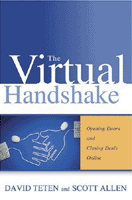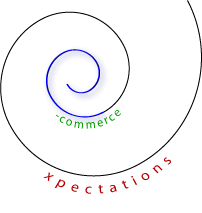A Must-read Guide to the Importance of Web 2.0 and the Knowledge Economy
 The Long Tail is a watershed book that reflects many of the profound socioeconomic changes wrought by the transition from the Industrial Economy to the Knowledge Economy. The “Long Tail” represents the splintering of the mass market—what is happening, why and how you can thrive in the new era of the niche. Moreover, it shows how the mass market was a temporary phenomenon that developed because niches were not economically viable for producers to address. The Long Tail is a watershed book that reflects many of the profound socioeconomic changes wrought by the transition from the Industrial Economy to the Knowledge Economy. The “Long Tail” represents the splintering of the mass market—what is happening, why and how you can thrive in the new era of the niche. Moreover, it shows how the mass market was a temporary phenomenon that developed because niches were not economically viable for producers to address.
Chris Anderson is editor-in-chief of Wired, and the book has an appreciation for culture, the economics of technology and the importance of innovation. It’s also very well written: Anderson tackles some fairly abstract concepts, but the reader doesn’t trip over them. It’s possible to read the book quickly, but there is plenty of substance for a detailed, reflective reading as well. Difficult to over-recommend!
The Long Tail offers an insightful look into the byte-oriented Knowledge Economy and its movement away from the zero-sum, bits-oriented Industrial Economy—and what this holds for business and culture. The book […]
 Consumer empowerment and disruption are being unleashed by the many-to-many Web. As we’ve been writing for some time, Web 2.0 is giving individuals collective voices that can rival the authority of global enterprises and governments, which is disruptive because it changes the rules. We call it Consumer Empowerment. Blogs, social networking, podcasts, wikis, vlogs and their intermediaries like Technorati, MySpace and iTunes give customers the tools to create and distribute content for free—instantly and globally. When rules change, you can quickly strengthen your market position by understanding and adapting more quickly than competitors. Consumer empowerment and disruption are being unleashed by the many-to-many Web. As we’ve been writing for some time, Web 2.0 is giving individuals collective voices that can rival the authority of global enterprises and governments, which is disruptive because it changes the rules. We call it Consumer Empowerment. Blogs, social networking, podcasts, wikis, vlogs and their intermediaries like Technorati, MySpace and iTunes give customers the tools to create and distribute content for free—instantly and globally. When rules change, you can quickly strengthen your market position by understanding and adapting more quickly than competitors.
Google any specific product, phrase or service, and you will notice that customer content is growing quickly, especially in specific, customer-centric areas that organizations aren’t focused on. Customers contribute customer-relevant content because they are passionate about the subject. Growing “tribes” of individuals connect, collaborate, and become smart very quickly. Threat: large organizations are losing control over the information about their reputations, products and services. Opportunity: adding value to these customer-led conversations can increase your credibility and appeal.
Large organizations attained their market power through efficiency, the hallmark of the […]
Excellent guidebook for succeeding in the online world, including social networking
 The Virtual Handshake is an immensely valuable book, both as a handbook to the virtual world for the business-oriented person and as a guide to purposeful networking. I was compelled to get it after seeing David Teten speak at a conference because he spoke with authority while explaining new things clearly. Allen and Teten have done a masterful job at writing an interesting book that is full of useful information. Moreover, they succeed at providing a conceptual framework, so the reader can make use of the information. It is also a fun read. The Virtual Handshake is an immensely valuable book, both as a handbook to the virtual world for the business-oriented person and as a guide to purposeful networking. I was compelled to get it after seeing David Teten speak at a conference because he spoke with authority while explaining new things clearly. Allen and Teten have done a masterful job at writing an interesting book that is full of useful information. Moreover, they succeed at providing a conceptual framework, so the reader can make use of the information. It is also a fun read.
As a marketing executive and a management consultant (strategy) since the early 1990s, I have helped to build parts of the virtual world the authors describe. I am very familiar with the topics, and I found the book useful on two key levels:
Conceptual: The virtual world is difficult to understand conceptually because it is boundaryless and serendipitous, and the authors describe what it is enough so you can get to the point: how to interact with it to accomplish what you want. This is extremely important […]
If you have started to get the feeling that something new and big is afoot in the consumer Web world, no, you’re not having flashbacks to 1997
 Web 2.0 is a new phenomenon that is beginning to realign the balance of power between producers/providers of products/services and customers because it enables customers to self-organize and wield unprecedented influence in the market. “Web 2.0” refers to a group of (usually) free user-friendly Web applications like blogs, wikis, integrated video/phone services and social networking sites (more below) that enable individuals to connect, collaborate and concatenate with unprecedented ease. E-Commerce (doesn’t it sound quaint now?) first enabled consumers to gain a new level of information about products and services and, as adoption proceeded, to buy over the Web. That was “Web 1.0” and it was still largely one-way communication because information flowed from the Web to customers. “Web 2.0” is focused on letting individuals self-organize, interact, collaborate and be equal players in what aficionados call “the conversation” of the Web. Web 2.0 is a new phenomenon that is beginning to realign the balance of power between producers/providers of products/services and customers because it enables customers to self-organize and wield unprecedented influence in the market. “Web 2.0” refers to a group of (usually) free user-friendly Web applications like blogs, wikis, integrated video/phone services and social networking sites (more below) that enable individuals to connect, collaborate and concatenate with unprecedented ease. E-Commerce (doesn’t it sound quaint now?) first enabled consumers to gain a new level of information about products and services and, as adoption proceeded, to buy over the Web. That was “Web 1.0” and it was still largely one-way communication because information flowed from the Web to customers. “Web 2.0” is focused on letting individuals self-organize, interact, collaborate and be equal players in what aficionados call “the conversation” of the Web.
Before you B2B-focused readers yawn and turn the page, consider that this will turn […]
At the turn of the 21st Century, converging social, technological and political changes demand profound changes in how organizations relate to their customers. These changes question many of the assumptions on which 20th Century businesses are built. To turn this situation to their advantage, executives need to approach how they create value for their customers, quickly and proactively. They must build a collaborative network of partners to discover, design and deliver differentiated experience to customers.
The new meaning of customer experience Pervasive e-business and global sourcing are creating new centers of excellence for knowledge, services and manufacturing around the world—these clusters of people and companies are technology-enabled, well educated and highly motivated. They will impact incumbents in several ways: 1) they represent new collaborative resources that can add significantly to the enterprise expertise network; 2) they are developing into high-growth consumer markets; 3) they will create new offerings that may change the rules of your business since their companies do not have legacy organizations and cost structures. Web 2.0 is mobilizing customers in high-value mature markets—”Web 2.0″ technologies are user-friendly, collaborative tools and work processes that enable customers to connect with each other and collaborate spontaneously. Examples are […]
The American Marketing Association Chicago Chapter held its Power Lunch round tables, 23 February 2006 in Chicago. I hosted Technology and Strategy tables, where marketing leaders from Fortune 1000 companies, startups and service providers exchanged impressions about emerging marketing trends and techniques. Here are my notes from the discussion.
[…]
In the post-Internet-boom period, it’s easy to forget about some old friends, so here I thought I’d drop in and revisit e-commerce…
 The old joke about commitment being like a ham and eggs breakfast certainly applies to producers (of goods) and consumers in the industrial economy. The punch line is that the chicken (consumer) is involved, but the pig (producer) is committed. The old joke about commitment being like a ham and eggs breakfast certainly applies to producers (of goods) and consumers in the industrial economy. The punch line is that the chicken (consumer) is involved, but the pig (producer) is committed.
A large part of producers’ inflexibility today is due to the fact that they are committed to bits (as opposed to bytes) at all stages of production and distribution: inputs, inventory, safety stocks, unsold goods, returns “… the whole catastrophe,” as Zorba says. These commitments are, in many cases, more important to producers than putting the customer first, and they represent a critical barrier to industrial economy companies’ intimacy with consumers because companies must sacrifice customer needs to maintain their operating realities. (For more on this, see Transformation: from Self-contained Company to Networked Global Organization.)
E-Commerce is steadily liberating producers from this dilemma in many categories. Let’s take a banal example. Probably most readers have shopped at “Earth’s Biggest Bookstore.” For many people, it defined the e-commerce experience. […]
A blog is not like a plant of the desert variety; it needs watering more often, so here’s an excerpt from my imminent Market Advisory on the marketing tectonic shift:
The Mirror: Customer Experience and Intimacy
We will see more changes in marketing practices from 2006-2015 than in the rest of the profession’s history because marketing will be the vanguard for the shift from an industrial economy to a knowledge economy, which will demand competence in all encompassing customer experience in order to achieve differentiation. Similarly, the globalization of markets is accelerating: emerging markets will represent extraordinary potential, but addressing them will demand unprecedented innovation. In a bright spot, ongoing CRM and BI initiatives, combined with continuing standardization of architecture (SOA) and messaging (Web services, XML), will begin to deliver the proverbial 360° view of the customer.
The Customer Experience Imperative
The customer experience will be mandated from producer and consumer quarters. Consumers have product fatigue. In many categories, there are too many choices with little differentiation save price. Producers will have unprecedented information, which they will explicitly use to create experiences. In fact, no consumer wants a product or service anyway; rather, consumers buy products and services in order […]
|
|
 The Long Tail is a watershed book that reflects many of the profound socioeconomic changes wrought by the transition from the Industrial Economy to the Knowledge Economy. The “Long Tail” represents the splintering of the mass market—what is happening, why and how you can thrive in the new era of the niche. Moreover, it shows how the mass market was a temporary phenomenon that developed because niches were not economically viable for producers to address.
The Long Tail is a watershed book that reflects many of the profound socioeconomic changes wrought by the transition from the Industrial Economy to the Knowledge Economy. The “Long Tail” represents the splintering of the mass market—what is happening, why and how you can thrive in the new era of the niche. Moreover, it shows how the mass market was a temporary phenomenon that developed because niches were not economically viable for producers to address.
 Consumer empowerment and disruption are being unleashed by the many-to-many Web. As we’ve been writing for some time, Web 2.0 is giving individuals collective voices that can rival the authority of global enterprises and governments, which is disruptive because it changes the rules. We call it Consumer Empowerment. Blogs, social networking, podcasts, wikis, vlogs and their intermediaries like Technorati, MySpace and iTunes give customers the tools to create and distribute content for free—instantly and globally. When rules change, you can quickly strengthen your market position by understanding and adapting more quickly than competitors.
Consumer empowerment and disruption are being unleashed by the many-to-many Web. As we’ve been writing for some time, Web 2.0 is giving individuals collective voices that can rival the authority of global enterprises and governments, which is disruptive because it changes the rules. We call it Consumer Empowerment. Blogs, social networking, podcasts, wikis, vlogs and their intermediaries like Technorati, MySpace and iTunes give customers the tools to create and distribute content for free—instantly and globally. When rules change, you can quickly strengthen your market position by understanding and adapting more quickly than competitors. The Virtual Handshake is an immensely valuable book, both as a handbook to the virtual world for the business-oriented person and as a guide to purposeful networking. I was compelled to get it after seeing David Teten speak at a conference because he spoke with authority while explaining new things clearly. Allen and Teten have done a masterful job at writing an interesting book that is full of useful information. Moreover, they succeed at providing a conceptual framework, so the reader can make use of the information. It is also a fun read.
The Virtual Handshake is an immensely valuable book, both as a handbook to the virtual world for the business-oriented person and as a guide to purposeful networking. I was compelled to get it after seeing David Teten speak at a conference because he spoke with authority while explaining new things clearly. Allen and Teten have done a masterful job at writing an interesting book that is full of useful information. Moreover, they succeed at providing a conceptual framework, so the reader can make use of the information. It is also a fun read. Web 2.0 is a new phenomenon that is beginning to realign the balance of power between producers/providers of products/services and customers because it enables customers to self-organize and wield unprecedented influence in the market. “Web 2.0” refers to a group of (usually) free user-friendly Web applications like blogs, wikis, integrated video/phone services and social networking sites (more below) that enable individuals to connect, collaborate and concatenate with unprecedented ease. E-Commerce (doesn’t it sound quaint now?) first enabled consumers to gain a new level of information about products and services and, as adoption proceeded, to buy over the Web. That was “Web 1.0” and it was still largely one-way communication because information flowed from the Web to customers. “Web 2.0” is focused on letting individuals self-organize, interact, collaborate and be equal players in what aficionados call “the conversation” of the Web.
Web 2.0 is a new phenomenon that is beginning to realign the balance of power between producers/providers of products/services and customers because it enables customers to self-organize and wield unprecedented influence in the market. “Web 2.0” refers to a group of (usually) free user-friendly Web applications like blogs, wikis, integrated video/phone services and social networking sites (more below) that enable individuals to connect, collaborate and concatenate with unprecedented ease. E-Commerce (doesn’t it sound quaint now?) first enabled consumers to gain a new level of information about products and services and, as adoption proceeded, to buy over the Web. That was “Web 1.0” and it was still largely one-way communication because information flowed from the Web to customers. “Web 2.0” is focused on letting individuals self-organize, interact, collaborate and be equal players in what aficionados call “the conversation” of the Web. The old joke about commitment being like a ham and eggs breakfast certainly applies to producers (of goods) and consumers in the industrial economy. The punch line is that the chicken (consumer) is involved, but the pig (producer) is committed.
The old joke about commitment being like a ham and eggs breakfast certainly applies to producers (of goods) and consumers in the industrial economy. The punch line is that the chicken (consumer) is involved, but the pig (producer) is committed.